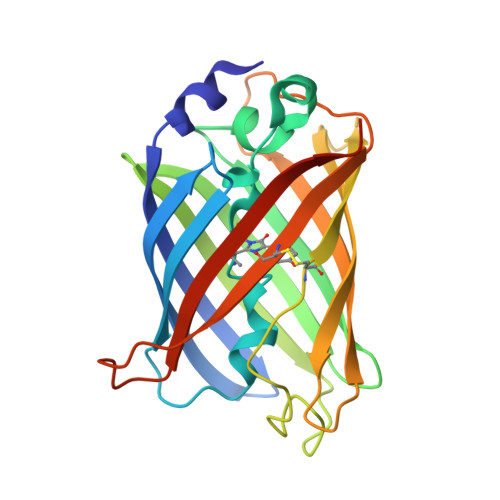Investigating mitochondrial redox potential with redox-sensitive green fluorescent protein indicators.
Hanson, G.T., Aggeler, R., Oglesbee, D., Cannon, M., Capaldi, R.A., Tsien, R.Y., Remington, S.J.(2004) J Biol Chem 279: 13044-13053
- PubMed: 14722062
- DOI: https://doi.org/10.1074/jbc.M312846200
- Primary Citation of Related Structures:
1JC0, 1JC1 - PubMed Abstract:
Current methods for determining ambient redox potential in cells are labor-intensive and generally require destruction of tissue. This precludes single cell or real time studies of changes in redox poise that result from metabolic processes or environmental influences. By substitution of surface-exposed residues on the Aequorea victoria green fluorescent protein (GFP) with cysteines in appropriate positions to form disulfide bonds, reduction-oxidation-sensitive GFPs (roGFPs) have been created. roGFPs have two fluorescence excitation maxima at about 400 and 490 nm and display rapid and reversible ratiometric changes in fluorescence in response to changes in ambient redox potential in vitro and in vivo. Crystal structure analyses of reduced and oxidized crystals of roGFP2 at 2.0- and 1.9-A resolution, respectively, reveal in the oxidized state a highly strained disulfide and localized main chain structural changes that presumably account for the state-dependent spectral changes. roGFP1 has been targeted to the mitochondria in HeLa cells. Fluorometric measurements on these cells using a fluorescence microscope or in cell suspension using a fluorometer reveal that the roGFP1 probe is in dynamic equilibrium with the mitochondrial redox status and responds to membrane-permeable reductants and oxidants. The roGFP1 probe reports that the matrix space in HeLa cell mitochondria is highly reducing, with a midpoint potential near -360 mV (assuming mitochondrial pH approximately 8.0 at 37 degrees C). In other work (C. T. Dooley, T. M. Dore, G. Hanson, W. C. Jackson, S. J. Remington, and R. Y. Tsien, submitted for publication), it is shown that the cytosol of HeLa cells is also unusually reducing but somewhat less so than the mitochondrial matrix.
Organizational Affiliation:
Department of Biology, Institute of Molecular Biology, University of Oregon, Eugene, OR 97403-1229, USA.















